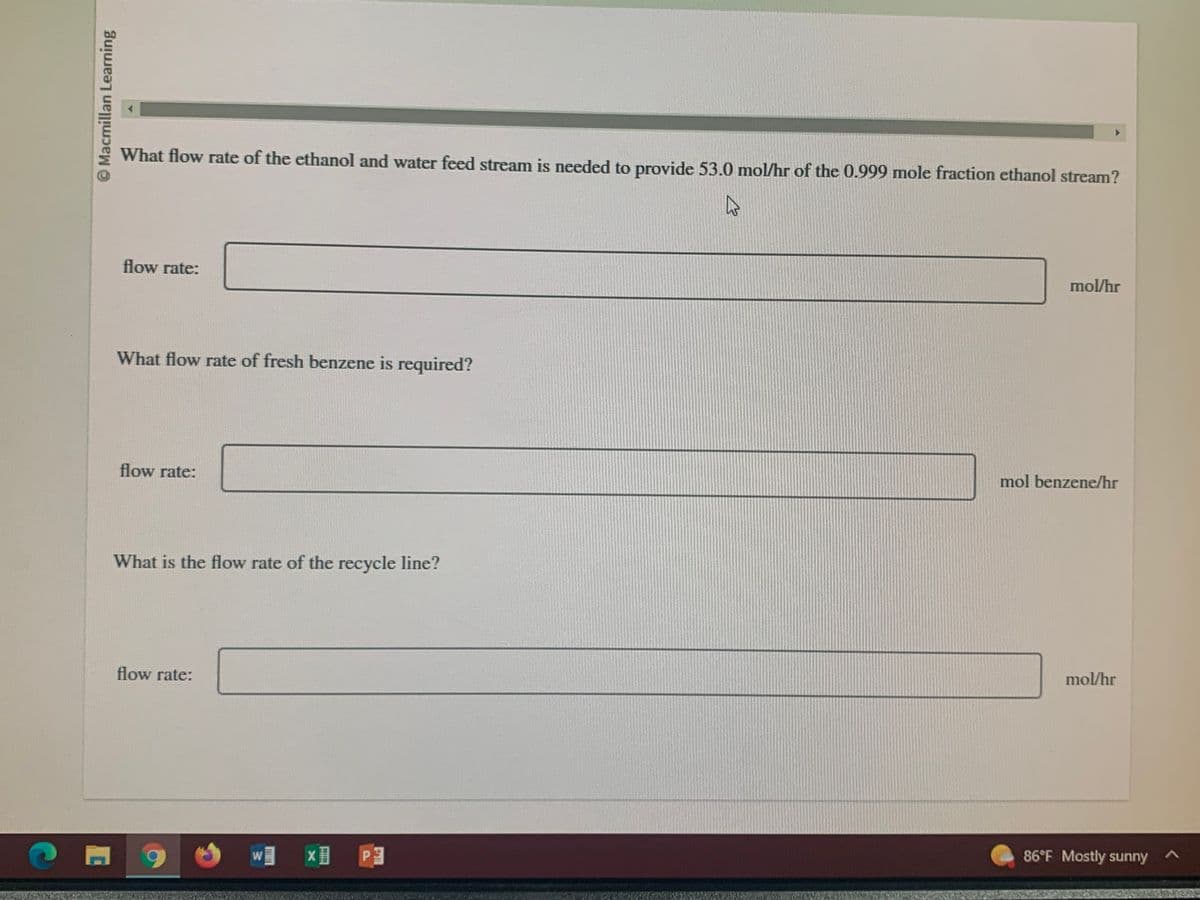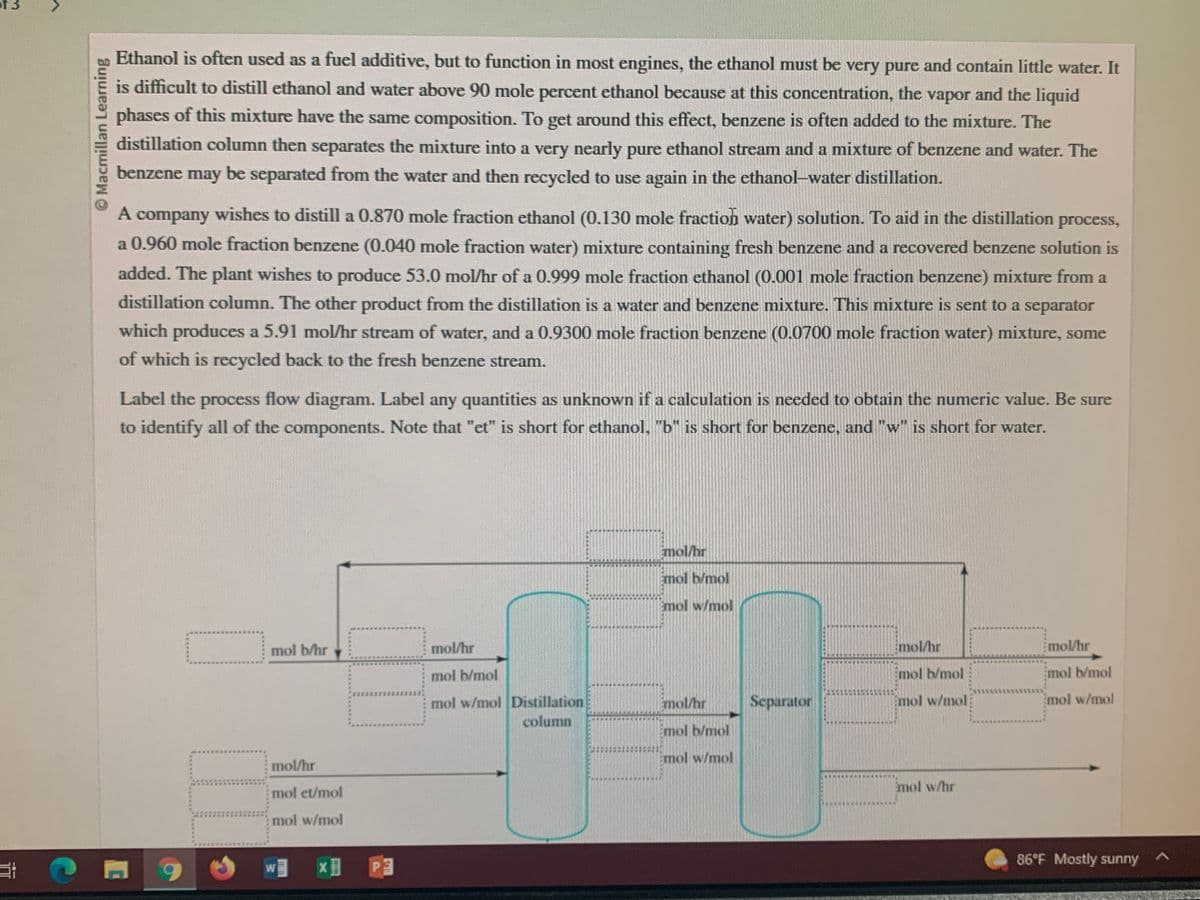Macmillan Learning Ethanol is often used as a fuel additive, but to function in most engines, the ethanol must be very pure and contain little water. It is difficult to distill ethanol and water above 90 mole percent ethanol because at this concentration, the vapor and the liquid phases of this mixture have the same composition. To get around this effect, benzene is often added to the mixture. The distillation column then separates the mixture into a very nearly pure ethanol stream and a mixture of benzene and water. The benzene may be separated from the water and then recycled to use again in the ethanol-water distillation. A company wishes to distill a 0.870 mole fraction ethanol (0.130 mole fraction water) solution. To aid in the distillation process, a 0.960 mole fraction benzene (0.040 mole fraction water) mixture containing fresh benzene and a recovered benzene solution is added. The plant wishes to produce 53.0 mol/hr of a 0.999 mole fraction ethanol (0.001 mole fraction benzene) mixture from a distillation column. The other product from the distillation is a water and benzene mixture. This mixture is sent to a separator which produces a 5.91 mol/hr stream of water, and a 0.9300 mole fraction benzene (0.0700 mole fraction water) mixture, some of which is recycled back to the fresh benzene stream. Label the process flow diagram. Label any quantities as unknown if a calculation is needed to obtain the numeric value. Be sure to identify all of the components. Note that "et" is short for ethanol, "b" is short for benzene, and "w" is short for water. mol b/hr mol/hr mol et/mol mol w/mol mol/hr mol b/mol mol w/mol Distillation column mol/hr mol b/mol mol w/mol mol/hr mol b/mol mol w/mol Separator mol/hr mol b/mol mol w/mol mol w/hr mol/hr mol b/mol mol w/mol
Macmillan Learning Ethanol is often used as a fuel additive, but to function in most engines, the ethanol must be very pure and contain little water. It is difficult to distill ethanol and water above 90 mole percent ethanol because at this concentration, the vapor and the liquid phases of this mixture have the same composition. To get around this effect, benzene is often added to the mixture. The distillation column then separates the mixture into a very nearly pure ethanol stream and a mixture of benzene and water. The benzene may be separated from the water and then recycled to use again in the ethanol-water distillation. A company wishes to distill a 0.870 mole fraction ethanol (0.130 mole fraction water) solution. To aid in the distillation process, a 0.960 mole fraction benzene (0.040 mole fraction water) mixture containing fresh benzene and a recovered benzene solution is added. The plant wishes to produce 53.0 mol/hr of a 0.999 mole fraction ethanol (0.001 mole fraction benzene) mixture from a distillation column. The other product from the distillation is a water and benzene mixture. This mixture is sent to a separator which produces a 5.91 mol/hr stream of water, and a 0.9300 mole fraction benzene (0.0700 mole fraction water) mixture, some of which is recycled back to the fresh benzene stream. Label the process flow diagram. Label any quantities as unknown if a calculation is needed to obtain the numeric value. Be sure to identify all of the components. Note that "et" is short for ethanol, "b" is short for benzene, and "w" is short for water. mol b/hr mol/hr mol et/mol mol w/mol mol/hr mol b/mol mol w/mol Distillation column mol/hr mol b/mol mol w/mol mol/hr mol b/mol mol w/mol Separator mol/hr mol b/mol mol w/mol mol w/hr mol/hr mol b/mol mol w/mol
Introduction to Chemical Engineering Thermodynamics
8th Edition
ISBN:9781259696527
Author:J.M. Smith Termodinamica en ingenieria quimica, Hendrick C Van Ness, Michael Abbott, Mark Swihart
Publisher:J.M. Smith Termodinamica en ingenieria quimica, Hendrick C Van Ness, Michael Abbott, Mark Swihart
Chapter1: Introduction
Section: Chapter Questions
Problem 1.1P
Related questions
Question

Transcribed Image Text:Macmillan Learning
What flow rate of the ethanol and water feed stream is needed to provide 53.0 mol/hr of the 0.999 mole fraction ethanol stream?
A
flow rate:
What flow rate of fresh benzene is required?
flow rate:
What is the flow rate of the recycle line?
flow rate:
9
W × P
mol/hr
mol benzene/hr
mol/hr
86°F Mostly sunny A

Transcribed Image Text:Macmillan Learning
Ethanol is often used as a fuel additive, but to function in most engines, the ethanol must be very pure and contain little water. It
is difficult to distill ethanol and water above 90 mole percent ethanol because at this concentration, the vapor and the liquid
phases of this mixture have the same composition. To get around this effect, benzene is often added to the mixture. The
distillation column then separates the mixture into a very nearly pure ethanol stream and a mixture of benzene and water. The
benzene may be separated from the water and then recycled to use again in the ethanol-water distillation.
A company wishes to distill a 0.870 mole fraction ethanol (0.130 mole fraction water) solution. To aid in the distillation process,
a 0.960 mole fraction benzene (0.040 mole fraction water) mixture containing fresh benzene and a recovered benzene solution is
added. The plant wishes to produce 53.0 mol/hr of a 0.999 mole fraction ethanol (0.001 mole fraction benzene) mixture from a
distillation column. The other product from the distillation is a water and benzene mixture. This mixture is sent to a separator
which produces a 5.91 mol/hr stream of water, and a 0.9300 mole fraction benzene (0.0700 mole fraction water) mixture, some
of which is recycled back to the fresh benzene stream.
Label the process flow diagram. Label any quantities as unknown if a calculation is needed to obtain the numeric value. Be sure
to identify all of the components. Note that "et" is short for ethanol, "b" is short for benzene, and "w" is short for water.
0
11
mol b/hr
mol/hr
mol et/mol
mol w/mol
W
X
Puffe
ORIEN
III
P
mol/hr
mol b/mol
mol w/mol Distillation
column
Emol/hr
Emol b/mol
Emol w/mol
mol/hr
Emol b/mol
mol w/mol
Separator
mol/hr
mol b/mol
Emol w/mol
mol w/hr
mol/hr
mol b/mol
Emol w/mol
86°F Mostly sunny
A
Expert Solution
This question has been solved!
Explore an expertly crafted, step-by-step solution for a thorough understanding of key concepts.
This is a popular solution!
Trending now
This is a popular solution!
Step by step
Solved in 2 steps with 2 images

Recommended textbooks for you

Introduction to Chemical Engineering Thermodynami…
Chemical Engineering
ISBN:
9781259696527
Author:
J.M. Smith Termodinamica en ingenieria quimica, Hendrick C Van Ness, Michael Abbott, Mark Swihart
Publisher:
McGraw-Hill Education

Elementary Principles of Chemical Processes, Bind…
Chemical Engineering
ISBN:
9781118431221
Author:
Richard M. Felder, Ronald W. Rousseau, Lisa G. Bullard
Publisher:
WILEY

Elements of Chemical Reaction Engineering (5th Ed…
Chemical Engineering
ISBN:
9780133887518
Author:
H. Scott Fogler
Publisher:
Prentice Hall

Introduction to Chemical Engineering Thermodynami…
Chemical Engineering
ISBN:
9781259696527
Author:
J.M. Smith Termodinamica en ingenieria quimica, Hendrick C Van Ness, Michael Abbott, Mark Swihart
Publisher:
McGraw-Hill Education

Elementary Principles of Chemical Processes, Bind…
Chemical Engineering
ISBN:
9781118431221
Author:
Richard M. Felder, Ronald W. Rousseau, Lisa G. Bullard
Publisher:
WILEY

Elements of Chemical Reaction Engineering (5th Ed…
Chemical Engineering
ISBN:
9780133887518
Author:
H. Scott Fogler
Publisher:
Prentice Hall


Industrial Plastics: Theory and Applications
Chemical Engineering
ISBN:
9781285061238
Author:
Lokensgard, Erik
Publisher:
Delmar Cengage Learning

Unit Operations of Chemical Engineering
Chemical Engineering
ISBN:
9780072848236
Author:
Warren McCabe, Julian C. Smith, Peter Harriott
Publisher:
McGraw-Hill Companies, The